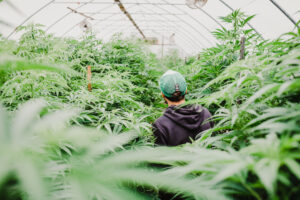How it's grown
This post is meant to help you understand a little bit more about the methods, mediums, and environments used in cannabis cultivation. Our collective of growers offers Naturally Grown (without chemical fungicides or pesticides) and LSO grown cannabis (100% organic inputs). Scroll down for pics from our outdoor gardens…
growing Methods
Living Soil Organic (LSO) Grown Cannabis
Is a method of growing cannabis that focuses on creating and maintaining a healthy, living ecosystem in the soil. It is typically seen as a type of “regenerative agriculture” that benefits both environemnt and people. It involves using organic materials and practices to build nutrient-rich soil that supports the growth of cannabis plants. LSO promotes a symbiotic relationship between the plant roots and beneficial microorganisms in the soil, aiming to mimic natural ecosystems. It avoids the use of synthetic fertilizers and pesticides, instead relying on organic amendments and techniques to maintain soil fertility and plant health. LSO is a sustainable and organic approach to cannabis cultivation that emphasizes the quality and terroir of the plants. This method of growing passes all organic certification standards. Growers and smokers alike tend to prefer LSO grown flower for its superior aroma, flavor, and natural organic quality. You can find all of our LSO cannabis here
Soil-less Growing
Soil-less cannabis cultivation refers to a method of growing cannabis plants without traditional soil. Instead, alternative growing mediums are used to support the plants’ root systems. These mediums can include materials such as coco coir, rockwool, perlite, vermiculite, or hydroponic systems. Nutrients are typically delivered to the plants through a liquid solution (hydroponic) or a controlled irrigation system. This method allows for precise control over nutrient levels, pH, and water content, and enables the grower to produce some of the most potent and high quality bud. Not all soil-less growing is done naturally or organically. Typically large indoor growing facilities focused on producing volume are using soilless methods, and in some cases using synthetic inputs which can contaminate the flower with heavy metals and a range of potentially carcinogenic chemicals. The Island Growers Collective only grows in small batches, strictly using all natural inputs (salt based & mined mineral nutrients, fish based ferts, compost teas, beneficial insects), so that everything we offer is chemical free, clean, and flower that we as growers feel comfortable smoking. Some of our indoor and AAAA cannabis is grown this way.
Conventional Farming (Not offered by Island Growers)
Conventionally grown cannabis refers to cannabis cultivated using common agricultural practices. This includes the use of synthetic fertilizers, chemical pesticides, and commercial products to maximize yields and control pests. Farms following such an approach do not prioritize organic or sustainable methods. Conventionally grown cannabis may not be as inherently healthy compared to cannabis cultivated using organic or natural methods. The use of synthetic fertilizers and chemical pesticides in conventional cultivation raises concerns about potential risks associated with these substances. These chemicals can leave residues on the plant and may impact the overall quality and safety of the cannabis.
Small Batch Craft Cannabis
Refers to a cultivation and production approach focused on producing cannabis in limited quantities on a smaller scale. Instead of mass production, small batch cannabis is typically grown in smaller facilities or even by individual cultivators. This method allows for more meticulous care, attention to detail, and quality control throughout the cultivation process. The emphasis is often on producing high-quality cannabis with unique characteristics, flavors, and effects. Small batch cannabis is often associated with craft or artisanal cultivation, where the focus is on quality rather than quantity.
Natural Inputs
Natural inputs refer to materials derived from natural sources, such as plant matter, minerals, or other naturally occurring substances.
Examples of Natural Inputs:
- Compost: Decomposed organic matter from plant residues, kitchen scraps, and yard waste.
- Manure: Animal waste (e.g., cow, chicken, or horse manure).
- Mineral Rocks: Naturally occurring minerals like rock phosphate or limestone.
- Cover Crops: Plants grown specifically to improve soil health and nutrient content.
Organic Inputs:
Organic inputs are specifically related to organic farming practices and adhere to organic certification standards. Organic inputs are approved for use in organic agriculture. They meet specific criteria related to origin, processing, and environmental impact.
Examples of Organic Inputs:
- Certified Organic Compost: Compost made from organic materials without synthetic chemicals.
- Bio-formulations: Natural products used for plant protection (e.g., neem oil or garlic spray).
- Organic Fertilizers: Approved organic fertilizers (e.g., fish emulsion, bone meal, or seaweed extract).
Difference Between Natural and Organic:
Certification: Organic inputs undergo certification processes to ensure compliance with organic standards.
Regulations: Organic inputs adhere to strict guidelines regarding their origin, processing, and impact on soil and ecosystems.
Overlap: Some natural inputs (like compost) can be both natural and organic if they meet organic criteria.
Balancing Natural and Organic:
While natural inputs are generally acceptable, organic growers prioritize inputs that align with organic principles.
Some natural inputs may not be considered organic due to factors like contamination or non-compliance with regulations.
In summary, natural inputs can be part of organic farming, but not all natural inputs automatically qualify as organic. Organic inputs are specifically tailored to meet organic standards and promote sustainable practices.
Growing Mediums
Soil Based Cultivation
Growing cannabis in a soil-based  medium means cultivating the plants in regular soil. The plants are rooted in the soil and draw nutrients and water from it. The soil is prepared with organic materials and fertilizers to provide the necessary nutrients. This method allows for a natural growth process and contributes to the flavor and quality of the cannabis.
medium means cultivating the plants in regular soil. The plants are rooted in the soil and draw nutrients and water from it. The soil is prepared with organic materials and fertilizers to provide the necessary nutrients. This method allows for a natural growth process and contributes to the flavor and quality of the cannabis.
Soil-less Based Cultivation
This refers to growing cannabis plants in a medium that does not contain soil but still provides some physical support and nutrient retention. Common soil-less mediums used in cannabis cultivation include coco coir, rockwool, perlite, vermiculite, and various blends of these materials. These mediums can retain moisture and nutrients while allowing for proper root aeration. In soil-less cultivation, plants are typically irrigated with a nutrient-rich water solution, and the medium acts as a substrate for the roots to grow into.
Hydroponics
Hydroponics is a soilless cultivation method that involves growing plants in a nutrient-rich water solution. Cannabis plants are typically placed in an inert growing medium like rockwool, coco coir, or perlite. The roots are constantly exposed to the nutrient solution, which is typically oxygenated to provide adequate oxygen to the roots. Hydroponic systems allow for precise control over nutrient delivery and can result in faster growth rates.
Growing Environments
Outdoor
Cannabis can be grown outdoors, taking advantage of natural sunlight. Outdoor cultivation requires suitable climate conditions, including warm temperatures, adequate sunlight, and a longer growing season. It can be a more cost-effective method compared to indoor cultivation, but it is subject to seasonal variations and environmental factors beyond control. Find all of our outdoor here.
Greenhouse
Greenhouses provide a controlled environment similar to indoor cultivation but utilize natural sunlight. They offer a balance between indoor and outdoor methods, providing some protection from the elements while allowing sunlight to nourish the plants. Greenhouses can extend the growing season and provide more environmental control compared to outdoor cultivation.
Indoor
This method involves growing cannabis plants indoors in a controlled environment. Indoor cultivation allows for precise control over temperature, humidity, lighting, and other environmental factors. It often utilizes artificial lighting systems, such as high-pressure sodium (HPS) or light-emitting diodes (LEDs), to mimic natural sunlight. Indoor growing offers some advantages that can potentially contribute to higher potency levels.
